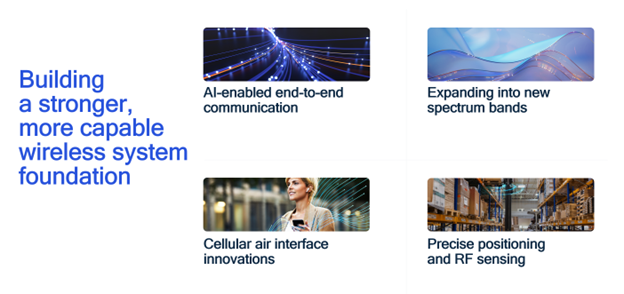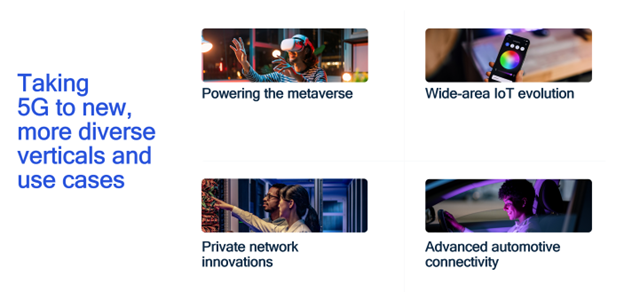Unveiling our most advanced wireless R&D prototypes and technology demonstrations for Mobile World Congress Barcelona 2023
John Smee, Senior Vice President, Engineering, Qualcomm Technologies, Inc
It’s that time of the year when one of the landmark events of the wireless communications industry, Mobile World Congress (MWC), takes place again in beautiful Barcelona, Spain. Each year, we bring forth our most advanced research progress, and this year at MWC-B 2023, we have a full lineup of technology demonstrations showcasing our latest innovations. These new technologies are fueling the 5G Advanced evolution as well as establishing the groundwork for 6G — the innovation platform for the next decade. If you are at the show physically, be sure to drop by our booth at Hall 3 Stand 3E10. But if not, you can still check out our virtual showroom. Let's dive into this year's technology showcase.
Building a stronger, more capable wireless system foundation

1. AI-enabled, end-to-end communication
There is little doubt that AI will play an essential role in the design and operations of 5G Advanced and beyond, as it is becoming increasingly useful in solving difficult wireless challenges. Today, we are only at the beginning of this journey, with our latest Snapdragon X75 5G modem-RF system being the World’s first integrated 5G AI processor with a dedicated tensor accelerator. Looking forward, we are working on multiple fronts.
- Advanced ML-based mmWave beam management: our 28 GHz over-the-air (OTA) test network now implements intelligent beam prediction at both the base stations and devices. This brings reduced signaling overhead that can improve usable network capacity and device battery life.
- Multi-vendor cross-node ML-based channel state feedback: our 3.5 GHz massive MIMO test network is configured to showcase sequential training, which can prevent sharing of proprietary neural network knowledge in a multi-vendor deployment.
WATCH VIDEO: AI-enabled, end-to-end communication demos
2. Expanding into new spectrum bands
Spectrum is the lifeblood of all wireless communications, and our innovations not only make existing spectrum more efficient, but they also unlock new bandwidths that can power next-generation devices and services. Today, our research focuses on making new higher band spectrum technically and economically viable for future commercial deployments.
- Giga-MIMO enabling wide-area coverage in 7 to 16 GHz: our Giga-MIMO design utilizes an order of magnitude more antennas than 5G massive MIMO to enable mobile communications. Our system simulation showcases significant throughput and capacity benefits in this band.
- Sub-terahertz communication in 100+ GHz: our OTA system can now utilize 8 simultaneous MIMO streams to reach speeds up to 300Gbps and distances close to 500m. In parallel, we also have a new mobile form-factor prototype with integrated phased array module.
WATCH VIDEO: Expanding into new spectrum bands demos
3. Cellular air interface innovations
At the foundation of every mobile technology platform is an air interface design that can support the full capabilities needed for the different targeted use cases. This year, we are showcasing how our air interface innovations can enable next-generation system performance and efficiency, including an expanded full duplex system design and techniques that can make future networks more sustainable.
- Path to full duplex: our 3.5 GHz subband full duplex test network can now operate at a higher transmit power level, thanks to interference mitigation (e.g., digital pre-distortion, non-linear interference cancellation). In addition, a full duplex wireless access/backhaul can improve system performance by exploiting spatial separation and mmWave beamforming.
- Green networks: by cancelling out noise in an iterative fashion, our super-QAM technology allows the network to operate its power amplifiers at a more optimal and power efficient operating point, as well as increase the modulation order to 16k-QAM over distances up to 400m. With this, the network can achieve both power savings and increased speeds under practical operating conditions.
WATCH VIDEO: Cellular air interface innovations demos
4. Precise positioning and RF sensing
One active research area for 5G beyond data communications is precise device positioning, which was first introduced in Release 16 and continues to be enhanced in 5G Advanced. To provide a new dimension of insights into our physical world, we are also working on RF sensing technologies, which can detect “device-free” objects (i.e., those that do not actively transmit or receive).
- Precise positioning everywhere: this year, we prototyped with ZTE to show DL-TDoA-based (downlink time difference of arrival) mmWave positioning in an outdoor OTA system in Shanghai. In addition, we pioneered ML-enabled industrial positioning in our indoor private network with challenging non-line of sight channel conditions.
- High-resolution sensing: we are prototyping early RF sensing technologies in our mmWave test networks. In our 28 GHz outdoor system, we can now detect multiple objects, and our indoor 60 GHz testbed can showcase monostatic sensing for AGV (automated guided vehicle) detection, localization, and tracking.
WATCH VIDEO: Precise positioning and RF sensing demos
Taking 5G to new, more diverse verticals and use cases
We are also working on a wide range of new technologies to accelerate the 5G expansion. This year, we focused on 4 main vertical areas that are representative of our research focus. They are outlined below.

1. Powering the metaverse
The metaverse is an ever-present spatial internet that spans the physical, digital, and virtual worlds, where everything and everyone can communicate and interact seamlessly. This year, we are showcasing how the future of the metaverse is powered by our cutting-edge research and industry leading products.
- Boundless AR with dynamic distributed compute: our test system emulates boundless AR traffic over a 3.5 GHz 5G test network (server-to-phone) and Wi-Fi 6 (phone-to-glasses). Based on 5G radio conditions, processing switches between remote and local compute for a better experience.
- 5G API for immersive applications: we developed a 5G API so that real-time cloud applications can dynamically adapt to changing radio and network conditions. Our demo shows how user experience can be improved in handover and high-mobility scenarios for cloud gaming.
- Perception-assisted 5G for enhanced XR: our advanced research also looks at how fusing XR perception with wireless can improve 5G performance. Our XR headset uses sensors (e.g., camera, IMU) to determine its precise movement to help with mmWave beam switching.
WATCH VIDEO: Powering the metaverse demos
2. Wide-area IoT evolution
We recently announced the Snapdragon X35, a brand new 5G modem-RF system that fully supports the NR-Light (RedCap) standard in Release 17. It allows 5G NR to efficiently connect to lower complexity IoT devices (e.g., smart watches, industrial sensors), and it continues to evolve in 5G Advanced. Our demonstration this year showcases some of the most advanced 5G IoT use cases.
- 5G IoT coverage extension with device mesh: our improved OTA test network not only showcases how device relays can cost-efficiently extend outdoor coverage with routing support, but also provide timing information for indoor devices that do not have access to GPS timing.
- Narrowband positioning for 5G IoT: for lower complexity devices that cannot take advantage of the high time-domain resolution of wider bandwidths, our OTA implementation of DL-AoD (downlink angle of departure), a device-based positioning technique, showcases cost/power-efficient positioning with 5 MHz devices.
WATCH VIDEO: Wide-area IoT expansion demos
3. Private network innovations
We continue to drive cutting-edge innovations that can improve private network performance, aiming at delivering faster throughput, lower latency, and improved reliability. In this year’s demonstrations, we look at two leading private network connectivity technologies, 5G and Wi-Fi, and see how our latest research can bring further improvements.
- Adaptive RAN operation for 5G private networks: Qualcomm Edgewise™ Suite features a service management and orchestration platform with a RAN intelligent controller that runs adaptive operation features. We showcase how it can detect different traffic profiles (e.g., for an AGV) and adapt a 5G private network automatically to meet stringent QoS requirements.
- Intelligent scheduling for virtualized 5G private networks: for industrial IoT applications, we showcased a virtualized 5G private network with 3GPP and O-RAN disaggregation, the benefits of ML-based interference prediction, and deployment scalability of a 5G private network.
- Multi-AP joint transmission for Wi-Fi: to significantly increase network data throughput in enterprise private networks, we demonstrate, for the first time, multiple Wi-Fi APs acting as a single antenna array for joint transmissions using precise OTA synchronization for phase, timing, and frequency.
WATCH VIDEO: Private network innovations demos
4. Advanced automotive connectivity
Automotive is one of the most important new verticals for 5G, and our wireless research team has been working on enabling advanced safety features. Looking forward, we are focusing on improving road safety for both vehicles and pedestrians. This includes bringing more environmental awareness through a wide range of wireless technologies.
- Cloud-based vulnerable road user safety: our advanced cloud platform can support new safety use cases targeting vulnerable users such as pedestrians and cyclists. By using network-to-device communications, the coarse location of smartphones can be used to generate timely, informational safety warnings for road users.
WATCH VIDEO: Advanced automotive connectivity demo
What’s next
There is a lot of work ahead of us to drive 5G Advanced evolution forward on the path to 6G. Stay tuned for future updates!
To see our newest technology demonstrations, check out this YouTube playlist.
Learn more about the 5G Advanced technology evolution at our 5G research webpage.
Sign up for our wireless technologies newsletter to stay up to date.

Snapdragon and Qualcomm branded products are products of Qualcomm Technologies, Inc. and/or its subsidiaries.